9 Great Trail Running Shoes for Fall Running
This article originally appeared on Trail Runner
Need new trail running shoes? Here is another collection of great models built for a wide range of terrain. As a general rule, the key to finding the best shoe for you is to get a pair that best matches the types of trails and the kind of running you'll be doing most of the time. But that can be difficult, which is why having more than one pair of shoes in your quiver can be important.
Asics Gel-Trabuco Max 2 | $150
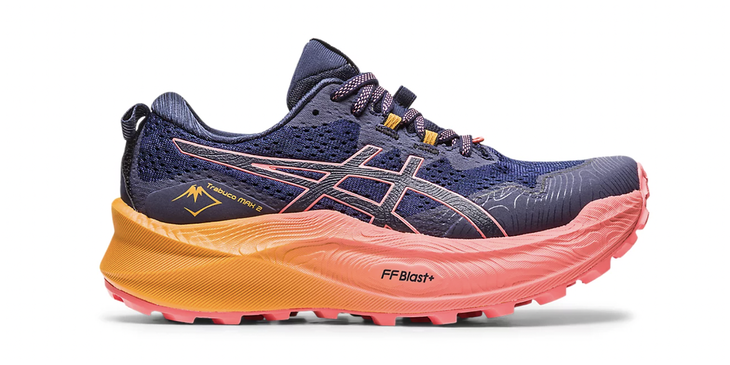
Weight: 9.5 ounces (women's size 8), 10.7 (men's size 9)
Heel-Toe Offset: 5mm (43mm in the heel, 38mm in the forefoot)
Fit: True to size with a medium interior volume and ample room in the toe box.
A true maximally cushioned trail shoe, the Gel-Trabuco Max 2 is built on a thick layer of responsive and cushy FlyteFoam Blast+ midsole foam that is found in many Asics road shoes. While that might seem like it would make it tipsy, it's actually quite stable thanks to the wide footprint and durable AsicsGrip rubber outsole that keep the foam from washing out. (Compared to other max-cush trail shoes like the Speedland GS:Tam, the Craft CTM Ultra Trail or Brooks Caldera, this fat bike-inspired Asics model has the best combination of stability and agility.)
Although it should be obvious, the Gel-Trabuco Max 2 is supremely cushy--including in its interior--which makes for a divinely soft, comfortable, and bouncy ride on smooth hard-packed and soft dirt trails. The extra cush feels great running downhill as the shoe plows through gravel, scree, and rocky features like a jet-assisted bulldozer. It generally doesn't get in the way (or feel like too much shoe) on most uphills, except when running over technical terrain. The extra girth doesn't allow it to be as smooth as a road-to-trail hybrid, but it excels in the midrange trails that have undulating, uneven terrain.
Plus: While it feels as comfy as an Asics road shoe, it's surprisingly good as a trail runner on most types of terrain.
Minus: The interior volume of the shoe can feel overly spacious if you're on more technical terrain. Runners with narrow feet might have to really cinch it down to keep their feet from swimming around inside.
Brooks Divide 4 | $100
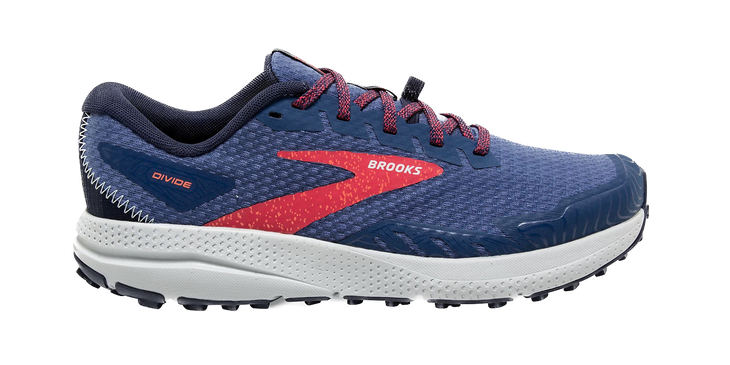
Weight: 9.4 ounces (women's size 8), 10.4 (men's size 9)
Heel-Toe Offset: 8mm (30mm in the heel, 22mm in the forefoot)
Fit: True to size with a medium interior volume and a little bit of wiggle room in the toe box, similar to what you'd expect from a Brooks road running shoe.
A $100 trail running shoe? Yes, believe it or not, this entry-level shoe holds its own on mild and moderate terrain, thanks to a combination of reliable traction, secure fit, interior comfort, and decent trail-specific protection. It's great on soft dirt and mildly technical terrain (with dirt, rocks, roots, gravel, etc.), offering very good stability from a wide footprint and semi-firm/semi-soft midsole and good traction from its low-profile outsole lugs. Those same elements also allow it to handle more technical terrain with rocky, jagged surfaces pretty well.
It's not a shoe for running craggy, high-alpine ridges, but it's comfortable and durable enough to rack up long miles on most types of terrain. Plus, the low-profile outsole lugs aren't an awkward hindrance while running over sections of paved roads or concrete bike paths as you combine surfaces during a long run. The semi-soft DNA Loft midsole allows for good shock absorption and a cushy sensation that serves up easy heel-to-toe transitions through the gait cycle but also contributes to the shoe's stability on uneven terrain. With a $100 price tag, the Brooks Divide 4 is a value-packed bargain as an entry-level shoe or as a versatile, secondary shoe in your quiver.
Plus: A capable, all-around shoe that can tackle smooth dirt trails and semi-technical routes.
Minus: Slightly heavier, less agile than a lot of trail running shoes on more technical terrain.
Craft Pure Trail | $170

Weight: 8.5 ounces (women's size 8), 10.2 ounces (men's size 9)
Heel-Toe Offset: 6mm (36mm in the heel, 30mm in the forefoot)
Fit: True to size with a high-volume interior that coincides with the wide, stable shape of the outsole/midsole chassis. Runners with wider feet will appreciate the extra room.
While it's hard to pick the best singular aspect of the Pure Trail, its combination of resilient cushioning, reliable traction, and a secure fit make it a great all-around trail running shoe. Think of it as a luxury SUV with plenty of creature comforts that also has the technical acuity to tackle off-road terrain. It features a single layer of Craft's high-rebound supercritical Cr midsole foam that provides a soft, responsive, and stable ride. Although it's not a featherweight model, it's not heavy, either, and the weight isn't noticeable on especially rocky, technical terrain.
With near-maximal midsole heights, it serves up a well-cushioned and moderately energetic ride. It has a flexible plastic rock plate embedded in the midsole of the forefoot that, along with the thick foam, helps mitigate the impact of pointy rocks underfoot. Even with the protective plate, the shoe still has an easy-flexing forefoot and isn't at all laterally tippy like some shoes with carbon-fiber plates. The dynamic structure of the airy one-piece TPU mesh upper is both highly breathable and exceptioally supportive, but it isn't very protective on the top or sides. The reinforced toe bumper does a good job protecting against stubbed toes, but it left testers' feet a bit vulnerable to sidewall abrasions.
Plus: A versatile, all-around shoe that can tackle a wide range of terrain.
Minus: The upper lacks protection.
Hoka Challenger ATR 7 | $145
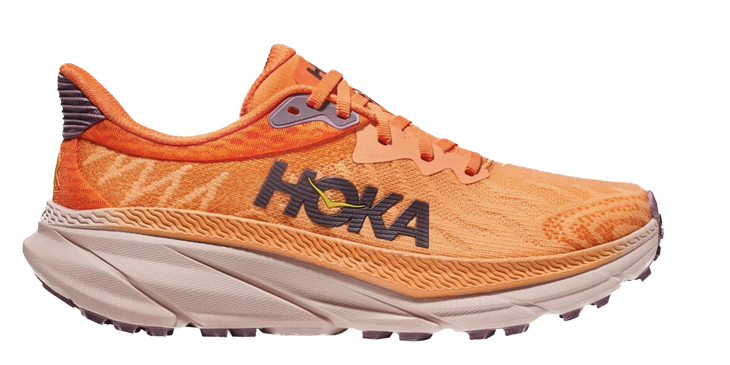
Weight: 7.9 ounces (women's size 8), 8.9 ounces (men's size 9)
Heel-Toe Offset: 5mm (29mm in the heel, 24mm in the forefoot)
Fit: True to size with a narrow interior volume and ample room in the toe box.
This seventh iteration of the Challenger ATR looks more like the brand's rugged trail models than the mild-mannered Challengers of the past. The 4mm lugs are smaller in the center of the outsole and larger around the perimeter (a strategy inspired by gravel bike tires that lets the shoe both roll over roads and dig into dirt), and the new outsole rubber does a slightly better job on technical terrain than previous versions of this shoe. There's more compression-molded EVA cushioning than in earlier versions, too. The signature Hoka cush--and the brand's notable rockered geometry--runs more like a monster truck than a ninja: it lets a runner just roll over rocks instead of picking their way around them. Yet it's still exceptionally light, soft and smooth.
The updated Challenger ATR 7 is a great road-to-trail hybrid shoe that excels at a wide variety of terrain, everything from paved roads and concrete bike paths to dirt trails and semi-technical routes with roots, rocks, and other obstacles. It offers the comfort and cushiness of your favorite road running shoes with reliable traction and stability needed for the uneven and always-changing terrain of the trails. It's not the most flexible shoe, but it is inherently stable, comfortable, and capable.
Plus: Impressively light and versatile.
Minus: Despite the improvements, it's still not ideal for rugged, rocky terrain.
Lowa Citux | $175
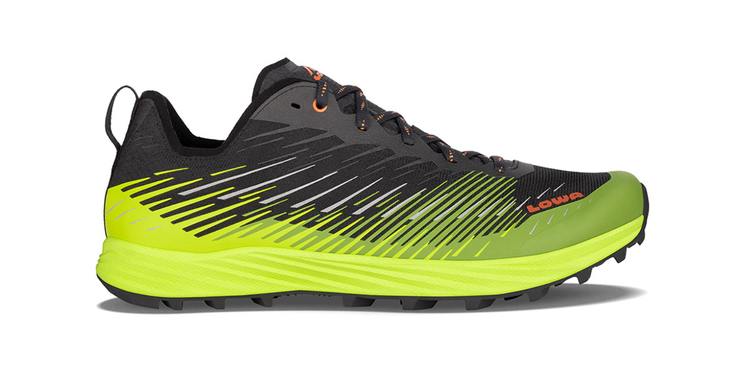
Weight: 7.6 ounces (women's size 8), 8.8 ounces (men's size 9)
Heel-Toe Offset: 4mm (21.6mm in the heel, 17.5mm in the forefoot)
Fit: True to size, but with a narrow, low-volume interior.
Lowa got into the trail running game more than 20 years ago, but after a brief absence in recent years, it made a roaring comeback in 2023 with three key models--the Citux, Amplux, and Fortux. All three shoes are durable, well-built models that vary in midsole thickness and protection. The Citux is the lightest and leanest of those models and most conducive for nimble, running on all types of terrain. Although it has a decidedly snug fit, its low-to-the-ground construction gives it exceptional proprioceptive feel for the trail for agile running on both mild and technical terrain.
It has a carbon-reinforced rebound plate that offers very good underfoot protection from sharp rocks as well as a touch of snappy energy return in every stride (on smoother terrain). Its ripstop fabric upper and reinforced toe bumper reduce the impacts of sidewall abrasions and stubbed toes, while the direction carbon-rubber outsole lugs do a really good job adhering to most dry dry surfaces, but not quite as well on wet rocks. One of the surprise shoes of the year, the Citux packs an impressive punch as a versatile shoe that does everything pretty well.
Plus: It's agile and grippy enough to be an exceptional short-distance racing shoe.
Minus: It has an extremely snug fit, even for runners with narrow feet.
Merrell MTL Skyfire 2 | $200
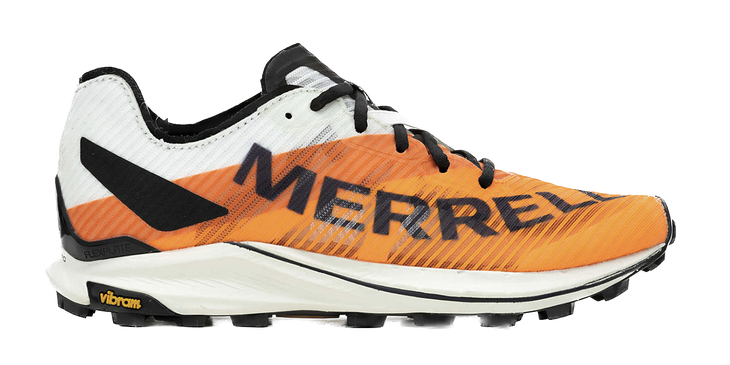
Weight: 5.8 ounces (women's size 8), 6.9 ounces (men's size 9)
Heel-Toe Offset: 6mm (25mm in the heel, 19mm in the forefoot)
Fit: True to size, but with a snug-fitting, low-volume interior.
Merrell built the Skyfire 2 from the ground up based on considerable input from its elite trail racing team, and the result is a lightweight shoe that's well-engineered for running fast over smooth, soft, and moderately technical terrain. Unlike max-cushioned trail runners with pillowy midsoles, the low-to-the-ground MTL Skyfire 2 feels light, nimble, fast, precise, and ideal for up-tempo training or short-distance trail racing. The step-in feel is sparse--with a thin sockliner, thin tongue, and modestly padded heel collar--but the locked-down fit and ultra-light construction inspires nimble strides and all-out speed.
The thin but responsive midsole provides sufficient cushioning for runners who are light on their feet and, thanks to the full-length plastic-composite flex plate, also gives a bit of energetic pop. It doesn't offer much trail-specific protection--however, the plate keeps you from feeling every pebble on the trail--but it allows for heightened proprioceptive interaction with the ground, which will allow you to run with more precision, more power, and more speed. There are plenty of other great features--including recycled materials and a treatment for natural odor control--but it's the combination of the outsole, midsole, and upper that make the MTL Skyfire 2 so exceptional.
Plus: Its combination of being extremely light and agile make it ideal for running fast.
Minus: There's not very much cushioning in the midsole.
New Balance FuelCell SuperComp Trail | $200
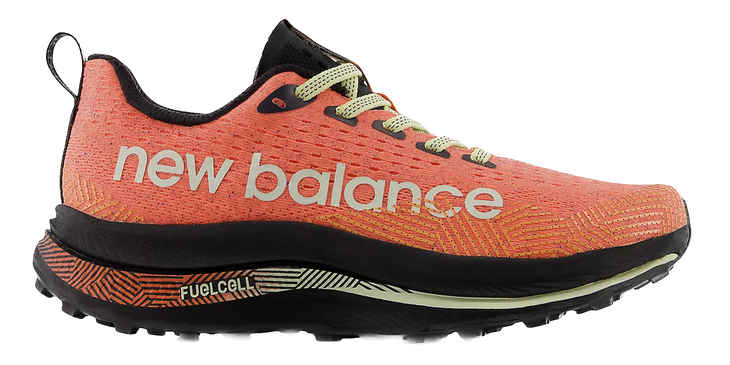
Weight: 7.9 ounces (women's size 8), 8.9 ounces (men's size 9)
Heel-Toe Offset: 8.5mm (38.5mm in the heel, 30mm in the forefoot)
Fit: True to size with a narrow/medium interior volume and a little bit of wiggle room in the pointy-shaped toe box.
The SuperComp Trail was engineered to be an agile, high-performance trail runner for short- to moderate-length runs at faster paces--and it delivers. It's a lightweight shoe that offers soft, resilient cushioning and a firm (but not rigid) carbon-fiber plate for a bit of propulsion and protection, all alongside a low-profile outsole that delivers good grip on most types of terrain. Although the trail running super shoe category is still rapidly evolving--at least compared to the seven-year evolution of carbon-fiber marathon racing shoes-- the New Balance Fuel Cell SuperComp Trail is on the short list of really good plated trail shoes that offer a good combination of soft, responsive foam, reliable traction and modest trail-specific protection.
The soft, energetic FuelCell midsole compound is evident the moment you start running, especially on firmer or more consistent terrain. It's the same supercritical foam formulation New Balance incorporates into its road running shoes, but the stack height isn't as high in the SuperComp Trail and it's not nearly as bouncy. It has near-maximal cushioning under the heel, but the stance is considerably lower to the ground at the forefoot, and that's one of the key reasons this shoe feels so nimble and maneuverable. The low-profile directional lugs of the Vibram Litebase rubber outsole provide reliable traction for running on loose dirt, sparse gravel, and both wet and dry solid rock faces (but are not ideal for muddy trails or coarse pebbles), while the cushy, plated midsole offers great underfoot protection. However, this shoe doesn't offer a lot of toe box or sidewall protection, even though the SC Trail's upper and toe bumper are modestly reinforced.
Plus: It's one of the most energetic trail shoes ever made.
Minus: The upper doesn't have much trail-specific protection and could put your toes in harm's way.
Nike Ultrafly | $260
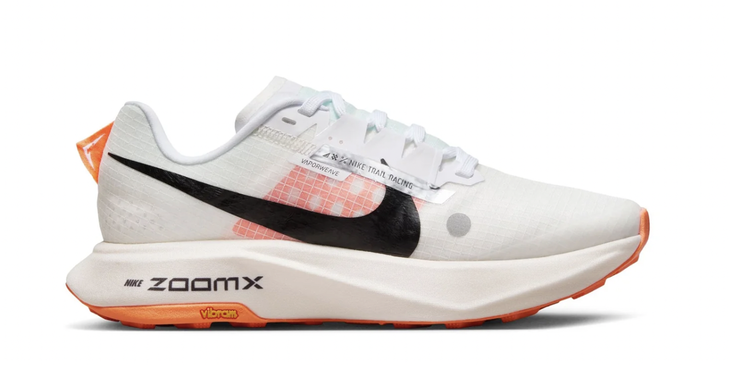
Weight: 8.7 ounces (women's size 8), 9.9 ounces (men's size 9)
Heel-Toe Offset: 8.5mm (38.5mm in the heel, 30mm in the forefoot)
Fit: True to size, with a narrow-medium interior volume but a little bit of toe wiggle room in the forefoot.
Although Nike is one of the biggest names in road running shoes, it wasn't until this year that the brand really established itself in the world of trail running. The mid-summer release of the lightweight, stable, grippy, and stable Ultrafly earned rave reviews for its soft, lively, and agile vibe on mild to moderate trail terrain, crushed gravel paths, and fire roads. Although the Ultrafly is not quite a max-cushioned shoe, it features the same ZoomX found in Nike's high-end Vaporfly and Alphafly marathon racing shoes. It's soft and responsive like a road running shoe, but not marshmallowy (thanks to the nylon mesh-reinforced wrapping of the midsole foam), and with a wide forefoot profile, it provides a good amount of inherent stability on off-camber terrain. That springy midsole, combined with a carbon-fiber propulsion plate--shorter than the road version and shaped like a two-pronged fork-- put a noticeable spring in every step, while the lower-to-the-ground forefoot provides an excellent proprioceptive feel for the trail that makes it conducive to quick footsteps and sharp cornering at faster speeds.
The Ultrafly is a little less at home on technical trail terrain, although the Vibram Litebase outsole rubber--a huge upgrade from all previous Nike trail running shoes--and interior plate do a good job at keeping underfoot stingers from sharp rocks at bay. The ripstop micromesh upper is modestly reinforced (but barely so around the toe box), and it could make your feet vulnerable to sidewall abrasions and stubbed toes on more rugged terrain.
Plus: The Ultrafly is like a fast, light, and energetic track shoe built for the trails.
Minus: The upper starts out pearly white, but quickly turns gray and dingy.
Speedland GS:TAM / GS: PGH / GS:OAK | $275
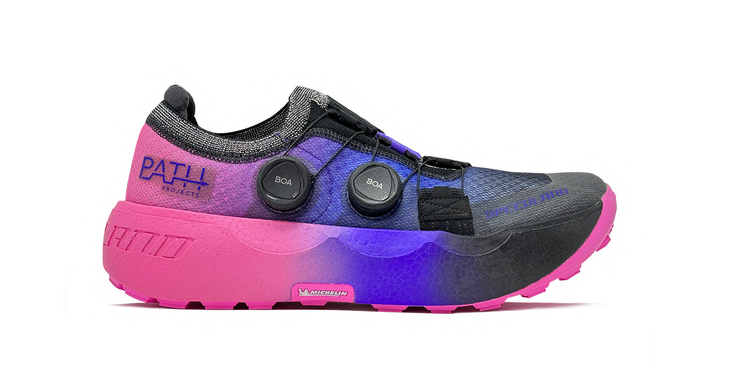
Weight: 9.5 ounces (women's size 8), 10.9 ounces (men's size 9)
Heel-Toe Offset: 7mm (37mm in the heel, 30mm in the forefoot)
Fit: True to size with a wide interior volume and ample room in the toe box, but also hyper-adjustability from the dual BOA closure mechanism.
This idealistic entrepreneurial start-up brand continues to turn the trail running world on its head with uniquely crafted shoes purpose-built with best-in-class materials and, yes, extremely lofty price tags. The GS:TAM (Dylan Bowman/FreeTrail), GS:PGH (Cameron Hanes), and GS:OAK (Liam Lonsdale/Path Projects) are essentially the same model in different colorways that represent the sponsored athlete tied to each model. All are built on a max-cushioned chassis that includes both an HTPU external midsole, a removable interior midsole made from a Pebax blend and a Michelin Fiber Lite outsole with 4.5mm lugs. This wide-body shoe is nothing if not stable, but the extra width tends to reduce its agility on technical terrain features.
Combined with a removable Carbitex GearFlex plate (sold separately) and the BOA Fit System upper, it gives this shoe exceptional adjustability that can be adapted to match a runner's fit and performance preferences for different types of terrain and different types of running. The multidirectional dual-dial Li2 BOA mechanism makes this shoe infinitely adjustable, both for initial step-in and mid-run adjustments. The interior volume is extremely spacious and even with a snug, locked down fit, it has a cavernous toe box. Speedland refers to its shoes as "equipment," and if you approach it like that--think about how a high-end alpine touring ski boot performs or the energy transmission of top-tier road cycling shoe--you'll start to understand the complex beauty of this shoe (and why it carries such a high price tag).
Plus: It's one of the cushiest and best-fitting running shoes ever made.
Minus: It can feel like "a lot of shoe" underfoot, depending on the terrain you're running on and how agile your gait is.
For exclusive access to all of our fitness, gear, adventure, and travel stories, plus discounts on trips, events, and gear, sign up for Outside+ today.
